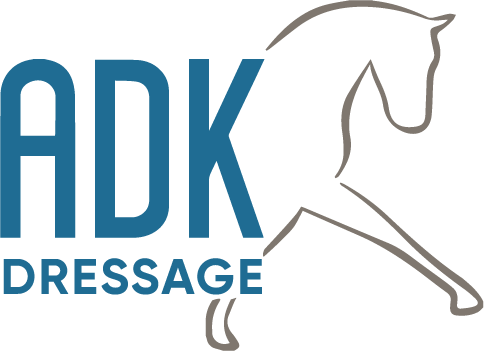MY PILATES STORY
Can I Do What I Ask My Horse to Do?
How Pilates Has Changed My Riding and Training
By Anne DeKeyser
 We all have that friend — the one that keeps harping on you to do something, don’t we? Mine is Michelle, a non-equestrian (I actually do have those friends too!). She’s a Physical Therapy Assistant, Pilates Instructor, and fellow dog walker (12 years and counting). On many of our dog walks we like to discuss body awareness and the effects it has on horseback riding. She kept telling me that I needed to try Pilates. I think it was put, “As a Type A personality, you would love it,” which were her words not mine. As trainer who would ride up to 8 horses per day I thought I was fit… I was using my core, right? And who has time for one more thing? Those were my thoughts until I ended up in the ER after I bent over to tie my shoes and couldn’t get up off the floor. After a MRI (not a fun time) and a doctor who told me I had a compressed disc in my lower lumbar and surgery was probably in my future, I took my friend’s advice and called the local Pilates studio.
We all have that friend — the one that keeps harping on you to do something, don’t we? Mine is Michelle, a non-equestrian (I actually do have those friends too!). She’s a Physical Therapy Assistant, Pilates Instructor, and fellow dog walker (12 years and counting). On many of our dog walks we like to discuss body awareness and the effects it has on horseback riding. She kept telling me that I needed to try Pilates. I think it was put, “As a Type A personality, you would love it,” which were her words not mine. As trainer who would ride up to 8 horses per day I thought I was fit… I was using my core, right? And who has time for one more thing? Those were my thoughts until I ended up in the ER after I bent over to tie my shoes and couldn’t get up off the floor. After a MRI (not a fun time) and a doctor who told me I had a compressed disc in my lower lumbar and surgery was probably in my future, I took my friend’s advice and called the local Pilates studio.
Starting was not easy. It was confusing…the instructor was so picky, and I didn’t sweat — how could this be exercise? For the sake of my back, I made time for it, religiously going to three mat classes per week. Soon I saw improvements: I was standing straighter, I was stronger, and my lower back didn’t hurt anymore. I was introduced to the reformer (a piece of equipment that looks like a medieval torture device) and found a way to enhance my symmetry and balance. I also began taking this new awareness over to my mat workouts. I became more aware of my body in general and more importantly, I was aware of my body on the horse. Was I centered (over the horse), concentrating, in control (of my body), precise (of what I was asking), flowing (with the horse) and breathing? These are all the the 6 Principles of Pilates. What I also discovered is that many of the same exercises I was doing in Pilates were working the exact same muscles I was asking my horses to use: rounding the back, lifting through the topline, engaging the core, connecting muscles diagonally, being straight and trying to move!
There were days my body just wouldn’t cooperate — try rolling like a ball when your back wants to be a square or thinking you’re straight and when corrected you feel crooked. When my Pilates instructor would ask for a new or advanced exercise, sometimes I didn’t get it correctly the first time, or the second. Sometimes not even that session and we would break it down to a basic exercise then try again next session. We didn’t drill it to where I was exhausted at trying. It got hard, and it got frustrating, but this gave me a better awareness of where my horses were physically and mentally. I realized some days their bodies just couldn’t do the exercise I put in front of them and they also would become frustrated. It was ok, I just needed to break it down to the basics or sometimes abort that exercise and bring it out again another day.
In early 2016 I broke my neck (C2) in a freak riding accident and was sent home on very strict house arrest. The neurosurgeon who oversaw my case told me I needed to start thinking of a lifestyle change. Taking that as a challenge, I practiced Pilates from my chair and standing at the kitchen counter. Four months later and after weeks of regular of physical therapy (thank you Michelle) I was sent straight back to the studio to finish my recovery. Pilates helped me come back stronger and quicker than ever and gave me the confidence I needed the first time I got back on a horse. Later that year I decided to become a certified Pilates instructor. Studying anatomy, assessing body types and conformation, and building on the fundamentals added a whole new level to my riding, training, and teaching.
What is Pilates?
The Pilates Method, founded by Joseph H Pilates in the 1920’s is based on a unique and proven philosophy of exercises and training that incorporates a precise and highly refined approach to teaching movement.
The exercises are designed to uniformly strengthen the entire body, training several muscles at once so that no muscle group is over or under trained. A body with balanced strength and flexibility is less likely to be injured and better able to move efficiently. Exercises become progressively demanding and at the advanced levels they ask that the core be engaged while flexing, bending, rotating, and extending the spine as well as giving the fullest range of motion possible in all joints of the body. Can you see the amazing correlation between Pilates and say, dressage or jumping?
Most people hear the word “core” and they immediately associate their core only with abdominal muscles, but your core consists of many more muscles. Your core will help in facilitating movement. In addition, it provides a home for your inner organs and central nervous system. In other words, a strong core helps you to do just about everything. When you start Pilates, you will work muscles you never knew you had!
Pilates creates:
- Strength
- Flexibility/Suppleness
- Coordination/Balance
- Stamina/Energy
- Straightness/Alignment
- Body Control/Self Carriage
Sound familiar? Isn’t this what we want in our horses? If we expect all of the above of our horses, how much more should we expect this of ourselves as well?
10 Reasons Why You Should Incorporate Pilates into your Dressage Training

Helps you isolate different body parts while remaining stable.

Improves your symmetry, offering multiple ways to challenge your body asymmetries and develop independent aids.

Increases your postural awareness which will help your position in the saddle.

Increases self-carriage in the rider.

Improves balance and alignment.

Helps with shoulder stability, which gives you better upper body control over fences and on the flat.

Understanding your own body will help you learn to self correct.

Develops body control required to keep you a balanced in the saddle.

Builds stamina within your muscles so you are less likely to collapse or arch your back.

A fit rider experiences less fatigue and is less likely to be injured and can enhance the horses performance.
Patience and persistence are vital qualities in the ultimate successful accomplishment of any worth while endeavor.
Contact me!
Whether you need help with Dressage or Pilates — or both — reach out today.

